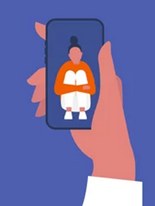Research
DEEPFAKES CAN CREATE NEGATIVE REPUTATION INSTANTLY, REGARDLESS OF VIDEO QUALITY
Jorrit Bakker, Sanne Schoenmakers, Uwe Matzat, Wijnand IJsselsteijn (2020)
Deepfakes are manipulated videoclips in which faces are swapped. As a result it looks as though a person says something that they never said in reality. In an experiment, subjects viewed deepfake videos and had to rate a number of personality characteristics about the person in the deepfake video. Results showed that people who were inserted into a negative video immediately suffered reputation damage, even in a poor quality deepfake where the alterations were visible.
Highlights:
People are poor at recognizing deepfakes;
Reputation damage occurs after association with a negative video, but association with a positive video does not improve one’s reputation.
Reputation damage occurs regardless of the quality of the deepfake.
Publication under review and will appear here soon
BRAIN-COMPUTER INTERFACE OPPORTUNITIES FOR ATAXIA PATIENTS
Maxine Derksen, Wolmet Barendregt, Sanne Schoenmakers (2021)
Brain Computer Interfaces (BCIs) are devices that can measure brain signals. They can then perform actions that are in line with what the wearer is thinking. This study focused on how BCIs can aid patients with ataxia. Ataxia is not a stand-alone disease, but rather a collection of symptoms that restrict voluntary muscle control. Results showed that ataxia patients were enthusiastic about using BCIs to aid them in performing actions that become too difficult over time, such as walking and speaking.
Highlights:
Ataxia patients have not been properly involved in BCI research so far;
Willingness of ataxia patients to participate in BCI research was strong;
Walking and talking are among the most prominent impairments for which patients would appreciate the aid of BCIs.
CHATBOTS FOR GRIEF MANAGAMENT
Christopher Smaak, Sanne Schoenmakers (2021)
Losing someone or something in life may cause feelings of grief. Grieving people often find it difficult to talk about their feelings to another, and prefer to hide from their grief. Unsuccessfully processing grief may in turn lead to complicated grief, involving prolonged periods of depression and anxiety. This study looked into the possibility to use chatbots as an accessible listeners for grieving people. Chatbots can be used privately and do not judge, which allows for low-threshold grief counseling. In this study, a pilot was run with a few participants and a chatbot with preprogrammed responses, and the results are promising.
Highlights:
The absence of a real person while talking about a loss was experienced as pleasant;
The participant felt that the robot did not give any judgment about their feelings;
Talking about grief without expectations increased the participant’s willingness to talk.
More information on this topic: Happy Again! project
EVALUATION OF MOBILE APPLICATIONS TO HELP COPING WITH GRIEF
Silke Franken, Sanne Schoenmakers (2021)
Feelings of grief are common in society, but not everyone knows how to cope with negative feelings. Avoidance to talk about it and the belief that negative feelings are not normal half a year after losing someone, may cause people to get stuck in the coping process. This study sought to find out whether an electronic application can be a low-threshold grief-handling aid. An example of such an application is psychoeducation, which teaches users that it is normal to experience grief and when a person should find help because they are getting stuck in the recovery process. Another example is supporting with emotional evaluation, which allows users to reflect on their emotions at regular moments. In total, ten application features were evaluated by mental health therapists and coaches.
Highlights:
Therapists might not be needed to aid clients with their grief management in most cases;
Therapists felt that almost all features could help people manage their grief from home. A blended learning setup can offer a different approach to each individual;
Therapists would also like to use such applications in their own practices.
More information on this topic: Happy Again! project
RISKS OF A MOBILE GRIEF COPING APPLICATION
Jasmijn de Joode, Sanne Schoenmakers (2021)
Grief is a common phenomenon in society, which can cripple a person temporarily due to depression or anxiety. This study investigated the risks of using a mobile-based application to provides grief support. The primary goal of the Happy again! Project is to prevent people from ending up in complicated grief. To that end, therapists were consulted to identify any possible risks related to the use of a grief counseling app in a home setting. Results showed that therapists did not pinpoint many serious risks in this study. Often, grieving patients merely require time to recover, and attention to their story to lower the burden of their problem. Time and attention can come from themselves, a therapist, or friends and family. Risks that were indicated to require special awareness in the app were those of substance abuse or addiction, and suicidal thoughts and behavior. In these cases reaching out to a professional therapist is strongly encouraged.
Highlights:
No adamant risks were anticipated for the use of a grief support application; Currently, most of the time people cope with grief at home themselves, an app would not change that, but could be supportive
Similar to the way coaches and therapists handle grieving patients, the application should offer patients a way to talk about their feelings.
Therapists were positive about the idea that an app could help, yet we only talked to very few people here so there could be a bias.
More information on this topic: Happy Again! project
A CRITICAL ANALYSIS OF THE USABILITY SCALE IN BUSINESS SETTINGS
Jolijn Hesen, Sanne Schoenmakers, Wolmet Barendregt (2021)
The System Usability Scale (SUS) is a standardized usability survey intended to measure people’s perceived usability of a product or system. This paper provides a critical analysis of the SUS in practice in a business environment. Furthermore, it gives an overview of which (other) methods of measuring usability are most effective in a real world case. The results show that the SUS did not provide more insightful information than a single question measuring usability. The most effective method was a combination of in-depth interviewing to allow some people to elaborate on their experience and a single question about usability to measure the opinion of the entire population of users of a system.
Highlights:
The long SUS did not provide more insights than a single question covering the same content. The correlation between SUS and a single question was .9;
In-depth interviews are most effective at inspecting the usability of a product or system because people can actually give detailed feedback then;
The standard SUS requires a long time to fill out, while repeated usability tests calls for a short measure to unburden employees.







